
Gatekeepers of the art world are up in arms over an exhibition on the Guggenheim Museum’s fall schedule. As reported in the New York Times last week, “The project, called ‘YouTube Play’ and conceived as a biennial event, is intended to discover innovative work from unexpected sources.” The Guggenheim, in other words, wants to curate a show of the best YouTube videos. Nancy Spector, deputy director and chief curator of the Guggenheim Foundation, says, “People who may not have access to the art world will have a chance to have their work recognized We’re looking for things we haven’t seen before.”
And then the hand-wringing began. Robert Storr, dean of the Yale University School of Art, a veritable quote machine for art-world issues, opined, “Hit-and-run, no-fault encounters between curators and artists, works and the public, will never give useful shape to the art of the present nor define the viewpoint of institutions.” Storr is smart, but this seemed misplaced and out of proportion for just wanting to get YouTube videos into the museum. He was more off base about this particular show when he added, “It’s time to stop kidding ourselves. The museum as revolving door for new talent is the enemy of art and of talent, not their friend — and the enemy of the public as well, since it … serves up art as if it was quick-to-spoil produce from a Fresh Direct warehouse.”
Again, while Storr’s values may be in the right place when it comes to museums and their mad obsession with newness, this doesn’t apply to the Guggenheim creating an open-source matrix to curate a show. YouTube videos are obviously a form of do-it-yourself art, outsider video, folk-expression, and other things the art world says it loves. Spector’s idea is actually fantastic. Who hasn’t seen something on YouTube and thought, “This is as good as anything I’ve seen in galleries and museums”? (My jaw still drops when I see that one of the sheep with LED lights on their backs being herded into amazing geometric patterns.) The Guggenheim simply wants to open its doors to art and ideas that are already out there. For four days, anyway. Four days! If this happens, the art world as we know it will not collapse. In fact, if the art world does not let in more of the real world — including YouTube — it is probable that the real world will let in less of the art world.




